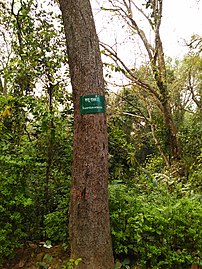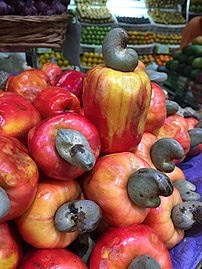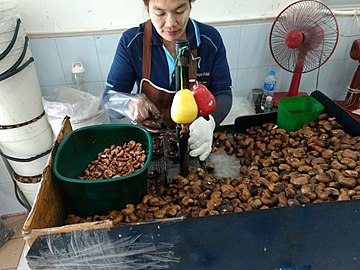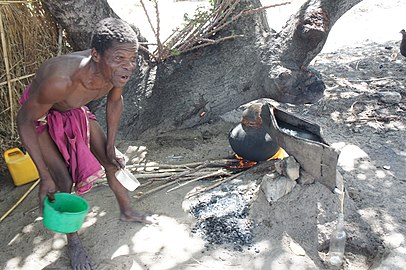Cashew
| Cashew | |
|---|---|

| |
| Ripe fruit and attached drupe, which contains the edible seed | |
| Scientific classification | |
| Kingdom: | Plantae |
| Clade: | Tracheophytes |
| Clade: | Angiosperms |
| Clade: | Eudicots |
| Clade: | Rosids |
| Order: | Sapindales |
| Family: | Anacardiaceae |
| Genus: | Anacardium |
| Species: | A. occidentale
|
| Binomial name | |
| Anacardium occidentale | |
Cashewis the common name of a tropicalevergreen treeAnacardium occidentale,in the familyAnacardiaceae.It is native toSouth Americaand is the source of the cashew nut and the cashew apple, anaccessory fruit.The tree can grow as tall as 14 metres (46 feet), but the dwarf cultivars, growing up to 6 m (20 ft), prove more profitable, with earlier maturity and greater yields. The cashewnutis edible and is eaten on its own as asnack,used in recipes, or processed into cashew cheese orcashew butter.The nut is often simply called a 'cashew'.
In 2019, four milliontonnesof cashew nuts were produced globally, withIvory CoastandIndiathe leading producers. As well as the nut and fruit, the plant has several other uses. The shell of the cashew seed yields derivatives that can be used in many applications including lubricants, waterproofing, paints, and, starting in World War II, arms production.[1][full citation needed]The cashew apple is a light reddish to yellow fruit, whose pulp and juice can be processed into a sweet,astringentfruit drink or fermented and distilled into liquor.
Description
[edit]The cashew tree is large andevergreen,growing to 14 metres (46 feet) tall, with a short, often irregularly shaped trunk.[2]Theleavesare spirally arranged, leathery textured, elliptic to obovate,4–22 centimetres (1+1⁄2–8+3⁄4inches) long and2–15 cm (3⁄4–6 in) broad, with smooth margins. Theflowersare produced in apanicleorcorymbup to 26 cm (10 in) long; each flower is small, pale green at first, then turning reddish, with five slender, acutepetals7–15 millimetres (1⁄4–5⁄8in) long.The largest cashew tree in the worldcovers an area around 7,500 m2(81,000 sq ft) and is located inNatal,Brazil.[citation needed]
The fruit of the cashew tree is anaccessory fruit(sometimes called a pseudocarp or false fruit).[3][4]What appears to be the fruit is an oval or pear-shaped structure, ahypocarpium,that develops from thepediceland the receptacle of the cashew flower.[5][6][2]Called the cashew apple, better known in Central America asmarañón,it ripens into a yellow or red structure about5–11 cm (2–4+1⁄4in) long.[3][6]
The true fruit of the cashew tree is akidney-shaped orbo xing glove-shapeddrupethat grows at the end of the cashew apple.[3]The drupe first develops on the tree and then the pedicel expands to become the cashew apple.[3]The drupe becomes the true fruit, a singleshell-encasedseed,which is often considered anutin the culinary sense.[3][6][7]The seed is surrounded by a double shell that contains an allergenicphenolicresin,[6]anacardic acid—which is a potent skinirritant[2]chemically related to the better-known and alsotoxicallergenic oilurushiol,which is found in the relatedpoison ivyandlacquer tree.
-
Botanical illustration
-
Tree inMozambique,southeastern Africa
-
Trunk inBangladesh
-
Flowers
-
Pollen grains of Cashew tree
-
Young fruits
-
Fruits sold as produce
Etymology
[edit]The English name derives from the Portuguese name for the fruit of the cashew tree:caju(Portuguese pronunciation:[kaˈʒu]), also known asacaju,which itself is from theTupiwordacajú,literally meaning "nut that produces itself".[3][4]
Thegeneric nameAnacardiumis composed of the Greek prefixana-(ἀνά-,aná,'up, upward'), the Greekcardia(καρδία,kardía,'heart'), and theNeo-Latinsuffix-ium.It possibly refers to the heart shape of the fruit,[8]to "the top of the fruit stem"[9]or to the seed.[10]The wordanacardiumwas earlier used to refer toSemecarpus anacardium(the marking nut tree) beforeCarl Linnaeustransferred it to the cashew; both plants are in the same family.[11]Theepithetoccidentalederives from the Western (or Occidental) world.[12]
The plant has diversecommon namesin various languages among its wide distribution range,[4]includinganacardier(French) with the fruit referred to aspomme de cajou,[13]caju(Portuguese pronunciation:[kaˈʒu]), oracaju(Portuguese).[3][4]
Distribution and habitat
[edit]The species is native to tropical South America[14]and later was distributed around the world in the 1500s byPortuguese explorers.[3][15][6]Portuguese colonists in Brazil began exporting cashew nuts as early as the 1550s.[16]The Portuguese took it toGoa,formerlyEstado da Índia Portuguesain India, between 1560 and 1565. From there, it spread throughout Southeast Asia and eventually Africa.[citation needed]
Cultivation
[edit]| Cashew production (with shell) 2021 | |
|---|---|
| Country | Production (tonnes) |
| 837,850 | |
| 738,000 | |
| 348,504 | |
| 255,931 | |
| 210,786 | |
| World | 3,708,153 |
| Source:FAOSTATof theUnited Nations[17] | |
The cashew tree is cultivated in the tropics between 25°N and 25°S, and is well-adapted to hot lowland areas with a pronounced dry season, where the mango and tamarind trees also thrive.[18]The traditional cashew tree is tall (up to 14 m (46 ft)) and takes three years from planting before it starts production, and eight years before economic harvests can begin.[19]
More recent breeds, such as the dwarf cashew trees, are up to 6 m (20 ft) tall, and start producing after the first year, with economic yields after three years. The cashew nut yields for the traditional tree are about 0.25 t/ha (0.100 long ton/acre; 0.11 short ton/acre), in contrast to over a ton per hectare for the dwarf variety. Grafting and other modern tree management technologies are used to further improve and sustain cashew nut yields in commercial orchards.[20][19]
Production
[edit]In 2021, global production of cashew nuts (as the kernel) was 3.7 milliontonnes,led by Ivory Coast and India with a combined 43% of the world total (table).
Trade
[edit]The top ten exporters of cashew nuts (in-shell; HS Code 080131) in value (USD) in 2021 were Ghana, Tanzania, Guinea-Bissau, Nigeria, Ivory Coast, Burkina Faso, Senegal, Indonesia, United Arab Emirates (UAE), and Guinea.
| 2017 | 2018 | 2019 | 2020 | 2021 | |
|---|---|---|---|---|---|
| World | 2.8B | 2.8B | 1.9B | 2.0B | 1.3B |
| 253.2M | 455.7M | 222.6M | 340.7M | 172.7M | |
| Tanzania | 530.0M | 426.8M | 221.4M | 362.0M | 159.0M |
| Guinea-Bissau | 318.0M | 129.0M | 122.8M | 128.5M | 143.6M |
| Nigeria | 69.3M | 191.1M | 74.5M | 94.4M | 138.8M |
| Ivory Coast | 1.0B | 1.1B | 730.8M | 612.0M | 129.7M |
| Burkina Faso | 144.8M | 198.9M | 81.0M | 53.3M | 96.0M |
| Senegal | 3.4M | 33.2M | 60.5M | 38.6M | 92.3M |
| Indonesia | 112.7M | 84.4M | 121.0M | 102.4M | 70.7M |
| UAE | 103.1K | 74.5M | 586.3K | 3.4M | 55.2M |
| Guinea | 161.6M | 41.2M | 45.2M | 35.7M | 53.1M |
| Source:[21] | |||||
From 2017 to 2021, the top ten exporters of cashew nuts (shelled; HS Code 080132) were Vietnam, India, the Netherlands, Germany, Brazil, Ivory Coast, Nigeria, Indonesia, Burkina Faso, and the United States.
In 2014, rapid growth of cashew cultivation in Ivory Coast made this country the top African exporter.[22]Fluctuations in world market prices, poor working conditions, and low pay for local harvesting have caused discontent in the cashew nut industry.[23][24][25]Almost all cashews produced in Africa between 2000 and 2019 were exported as raw nuts which are much less profitable than shelled nuts.[26]One of the goals of theAfrican Cashew Allianceis to promote Africa's cashew processing capabilities to improve the profitability of Africa's cashew industry.[27]
In 2011,Human Rights Watchreported thatforced labourwas used for cashew processing in Vietnam. Around 40,000 current or former drug users were forced to remove shells from "blood cashews"or perform other work and often beaten at more than 100 rehabilitation centers.[28][29]
| 2017 | 2018 | 2019 | 2020 | 2021 | |
|---|---|---|---|---|---|
| World | 5.5B | 5.1B | 4.7B | 4.5B | 4.2B |
| Vietnam | 3.4B | 3.2B | 3.0B | 2.9B | 2.7B |
| India | 959.9M | 673.6M | 569.6M | 407.9M | 437.8M |
| Netherlands | 302.8M | 304.3M | 248.3M | 266.0M | 281.8M |
| Germany | 168.1M | 179.8M | 174.5M | 202.3M | 183.2M |
| Brazil | 114.2M | 117.0M | 121.3M | 91.0M | 96.8M |
| Ivory Coast | 73.2M | 97.1M | 68.4M | 110.4M | 81.8M |
| Nigeria | 12.0M | 20.2M | 37.3M | 20.1M | 45.0M |
| Indonesia | 60.2M | 55.6M | 57.0M | 45.7M | 40.7M |
| Burkina Faso | 12.1M | 13.8M | 18.9M | 16.3M | 21.6M |
| United States | 33.5M | 26.3M | 22.7M | 21.1M | 19.8M |
| Source:[30] | |||||
Toxicity
[edit]Some people areallergicto cashews, but they are a less frequentallergenthan other tree nuts orpeanuts.[31]For up to 6% of children and 3% of adults, consuming cashews may causeallergic reactions,ranging from mild discomfort to life-threateninganaphylaxis.[32][33][34][35]These allergies are triggered by the proteins found in tree nuts, and cooking often does not remove or change these proteins.[36]Reactions to cashew and tree nuts can also occur as a consequence of hidden nut ingredients or traces of nuts that may inadvertently be introduced during food processing, handling, or manufacturing.[33][34]
Theshellof the cashew nut contains oil compounds that can causecontact dermatitissimilar topoison ivy,primarily resulting from thephenolic lipids,anacardic acid,andcardanol.[6][37]Because it can cause dermatitis, cashews are typically not sold in the shell to consumers.[38]Readily and inexpensively extracted from the waste shells, cardanol is under research for its potential applications innanomaterialsandbiotechnology.[39]
Uses
[edit]Nutrition
[edit]| Nutritional value per 100 g (3.5 oz) | |||||||||||||||||||||||||||||||||||||||||||||||||||||||
|---|---|---|---|---|---|---|---|---|---|---|---|---|---|---|---|---|---|---|---|---|---|---|---|---|---|---|---|---|---|---|---|---|---|---|---|---|---|---|---|---|---|---|---|---|---|---|---|---|---|---|---|---|---|---|---|
| Energy | 553 kcal (2,310 kJ) | ||||||||||||||||||||||||||||||||||||||||||||||||||||||
30.19 g | |||||||||||||||||||||||||||||||||||||||||||||||||||||||
| Starch | 23.49 g | ||||||||||||||||||||||||||||||||||||||||||||||||||||||
| Sugars | 5.91 g 0.00 g | ||||||||||||||||||||||||||||||||||||||||||||||||||||||
| Dietary fiber | 3.3 g | ||||||||||||||||||||||||||||||||||||||||||||||||||||||
43.85 g | |||||||||||||||||||||||||||||||||||||||||||||||||||||||
| Saturated | 7.783 g | ||||||||||||||||||||||||||||||||||||||||||||||||||||||
| Monounsaturated | 23.797 g | ||||||||||||||||||||||||||||||||||||||||||||||||||||||
| Polyunsaturated | 7.845 g | ||||||||||||||||||||||||||||||||||||||||||||||||||||||
18.22 g | |||||||||||||||||||||||||||||||||||||||||||||||||||||||
| |||||||||||||||||||||||||||||||||||||||||||||||||||||||
| Other constituents | Quantity | ||||||||||||||||||||||||||||||||||||||||||||||||||||||
| Water | 5.20 g | ||||||||||||||||||||||||||||||||||||||||||||||||||||||
| †Percentages estimated usingUS recommendationsfor adults,[40]except for potassium, which is estimated based on expert recommendation fromthe National Academies.[41] | |||||||||||||||||||||||||||||||||||||||||||||||||||||||
Raw cashews are 5% water, 30%carbohydrates,44%fat,and 18%protein(table). In a 100-gram reference amount, raw cashews provide 553kilocalories,67% of theDaily Value(DV) in total fats, 36% DV ofprotein,13% DV ofdietary fiberand 11% DV ofcarbohydrates.[42]Cashews are rich sources (20% or more of the DV) ofdietary minerals,including particularlycopper,manganese,phosphorus,andmagnesium(79–110% DV), and ofthiamin,vitamin B6andvitamin K(32–37% DV).[42]Iron,potassium,zinc,andseleniumare present in significant content (14–61% DV) (table).[42]Cashews (100 g, raw) contain 113 milligrams (1.74 gr) ofbeta-sitosterol.[42]
Nut and shell
[edit]Culinary uses for cashew seeds in snacking and cooking are similar to those for all tree seeds called nuts.[3][6]
Cashews are commonly used inSouth Asian cuisine,whole for garnishing sweets or curries, or ground into a paste[6]that forms a base of sauces for curries (e.g.,korma), or some sweets (e.g.,kaju barfi). It is also used in powdered form in the preparation of several Indian sweets and desserts. InGoan cuisine,both roasted and raw kernels are used whole for making curries and sweets. Cashews are also used inThaiandChinese cuisines,generally in whole form. In the Philippines, cashew is a known product ofAntipolo,and is eaten withsuman.The province ofPampangaalso has a sweet dessert calledturrones de casuy,which is cashewmarzipanwrapped in white wafers. In Indonesia, roasted and salted cashews are calledkacang meteorkacang mede,while the cashew apple is calledjambu monyet(lit.‘monkey rose apple’).[citation needed]
In the 21st century, cashew cultivation increased in several African countries to meet the demands for manufacturingcashew milk,aplant milkalternative todairy milk.[43]In Mozambique,bolo polanais a cake prepared using powdered cashews and mashed potatoes as the main ingredients. This dessert is common in South Africa.[44]
-
Women shelling cashews inBurkina Faso,West Africa
-
A woman using a machine to shell cashews in Thailand, wearing gloves to protect againstcontact dermatitis
-
Salted, roasted cashew nuts
-
Cashew sprouts are eaten raw or cooked
Husk
[edit]The cashew nut kernel has a slight curvature and twocotyledons,each representing around 20–25% of the weight of the nut. It is encased in a reddish-brown membrane called a husk, which accounts for approximately 5% of the total nut. Cashew nut husk is used in emerging industrial applications, such as anadsorbent,composites,biopolymers,dyesand enzyme synthesis.[45]
Apple
[edit]The mature cashew apple can be eaten fresh, cooked in curries, or fermented into vinegar, citric acid[46]or an alcoholic drink.[6]It is also used to make preserves, chutneys and jams in some countries, such as India and Brazil.[6]In many countries, particularly in South America, the cashew apple is used to flavor drinks, both alcoholic and nonalcoholic.[3][2]
In Brazil, cashew fruit juice and the fruit pulp are used in the production of sweets, juice, mixed with alcoholic beverages such ascachaça,and as a flour, milk, or cheese.[47]In Panama, the cashew fruit is cooked with water and sugar for a prolonged time to make a sweet, brown, paste-like dessert calleddulce de marañón(marañónbeing a Spanish name for cashew).[48]
Cashew nuts are more widely traded than cashew apples, because the fruit, unlike the nut, is easily bruised and has a very limited shelf life.[49]Cashew apple juice, however, may be used for manufacturing blended juices.[49]
When the apple is consumed, itsastringencyis sometimes removed by steaming the fruit for five minutes before washing it in cold water.Steepingthe fruit in boiling salt water for five minutes also reduces the astringency.[50]
In Cambodia, where the plant is usually grown as an ornamental rather than an economic tree, the fruit is a delicacy and is eaten with salt.[13]
Alcohol
[edit]In the Indian state ofGoa,the ripened cashew apples are mashed, and the juice, called "neero", is extracted and kept for fermentation[6]for a few days. This fermented juice then undergoes a double distillation process. The resulting beverage is calledfenior fenny.Feniis about 40–42% alcohol (80–84 proof). The single-distilled version is calledurrak,which is about 15% alcohol (30 proof).[51]In Tanzania, the cashew apple (biboinSwahili) is dried and reconstituted with water and fermented, then distilled to make a strong liquor calledgongo.[52]
Nut oil
[edit]Cashew nut oil is a dark yellow oil derived from pressing the cashew nuts (typically from lower value broken chunks created accidentally during processing), and is used for cooking or as a salad dressing. The highest quality oil is produced from a single cold pressing.[53]
Shell oil
[edit]Cashew nutshell liquid (CNSL) or cashew shell oil (CAS registry number8007-24-7) is a naturalresinwith a yellowishsheenfound in thehoneycomb structureof the cashew nutshell, and is a byproduct of processing cashew nuts. As it is a strong irritant, it should not be confused with the edible cashew nut oil. It is dangerous to handle in small-scale processing of the shells, but is itself a raw material with multiple uses.[39]It is used in tropicalfolk medicineand for anti-termitetreatment of timber.[54]Its composition varies depending on how it is processed.
- Cold,solvent-extractedCNSL is mostly composed ofanacardic acids(70%),[55]cardol(18%) andcardanol(5%).[39][56]
- Heating CNSLdecarboxylatesthe anacardic acids, producing a technical grade of CNSL that is rich in cardanol.Distillationof this material gives distilled, technical CNSL containing 78% cardanol and 8% cardol (cardol has one morehydroxylgroup than cardanol).[56]This process also reduces the degree of thermalpolymerizationof the unsaturated alkyl-phenols present in CNSL.
- Anacardic acid is also used in the chemical industry for the production of cardanol, which is used for resins, coatings, and frictional materials.[55][56]
These substances are skin allergens, likelacquerand the oils of poison ivy, and they present a danger during manual cashew processing.[54]
This natural oil phenol has interesting chemical structural features that can be modified to create a wide spectrum of biobasedmonomers.These capitalize on the chemically versatile construct, which contains threefunctional groups:thearomatic ring,thehydroxyl group,and thedouble bondsin the flankingalkylchain. These includepolyols,which have recently seen increased demand for their biobased origin and key chemical attributes such as high reactivity, range of functionalities, reduction in blowing agents, and naturally occurring fire retardant properties in the field of rigid polyurethanes, aided by their inherent phenolic structure and larger number of reactive units per unit mass.[39]
CNSL may be used as a resin forcarbon compositeproducts.[57]CNSL-basednovolacis another versatile industrial monomer deriving from cardanol typically used as areticulatingagent (hardener) forepoxymatrices incompositeapplications[58]providing good thermal and mechanical properties to the final composite material.[59]
Animal feed
[edit]Discarded cashew nuts unfit for human consumption, alongside the residues of oil extraction from cashew kernels, can be fed to livestock. Animals can also eat the leaves of cashew trees.[60]
Other uses
[edit]As well as the nut and fruit, the plant has several other uses. In Cambodia, the bark gives a yellow dye, the timber is used in boat-making, and for house-boards, and the wood makes excellent charcoal.[13]The shells yield a black oil used as a preservative and water-proofing agent invarnishes,cements, and as alubricantor timber seal.[6]Timber is used to manufacture furniture, boats, packing crates, andcharcoal.[6]Its juice turns black on exposure to air, providing an indelible ink.[6]
See also
[edit]- List of culinary nuts
- Semecarpus anacardium(the Oriental Anacardium), a native of India and closely related to the cashew
References
[edit]- ^Jostock, "Cashew Industry", p. 5.
- ^abcd"Cashew".Encyclopedia Britannica. 7 April 2020.Retrieved8 May2021.
- ^abcdefghijMorton, Julia F.(1987).Cashew apple,Anacardium occidentaleL.; In: Fruits of Warm Climates.Center for New Crops and Plant Products, Department of Horticulture and Landscape Architecture, Purdue University, W. Lafayette, Indiana. pp. 239–240.ISBN978-0-9610184-1-2.Archivedfrom the original on 15 March 2007.Retrieved18 March2007.
- ^abcd"Anacardium occidentale(cashew nut) ".CABI. 20 November 2019.Retrieved8 May2021.
- ^Varghese, T.; Pundir, Y. (1964). "Anatomy of the pseudocarp inAnacardium occidentaleL. ".Proceedings of the Indian Academy of Sciences, Section B.59(5): 252–258.doi:10.1007/BF03052341.S2CID83230755.
- ^abcdefghijklmnJames A Duke (1983)."Anacardium occidentaleL. "Handbook of Energy Crops. (unpublished); In: NewCROP, New Crop Resource Online Program, Center for New Crops and Plant Products, Purdue University.Retrieved10 December2019.
- ^Kapinga, F. A.; Kasuga, L. J. F.; Kafiriti, E. M."Growth and production of cashew nut"(PDF).Soils, Plant Growth and Crop Production.Encyclopedia of Life Support Systems.Retrieved9 April2021.
- ^Quattrocchi, Umberto (2016).World Dictionary of Medicinal and Poisonous Plants.CRC. p. 266.ISBN978-1-4822-5064-0.
referring to the shape of the fruit
- ^Merriam-Webster:"from the heartlike shape of the top of the fruit stem"
- ^George Milbry Gould (1898).An Illustrated Dictionary of Medicine, Biology and Allied Sciences: Including the Pronunciation, Accentuation, Derivation, and Definition of the Terms Used in Medicine, Anatomy, Surgery...P. Blakiston. p. 73.
ἀνά,up;καρδία,the heart, from its heart-shaped seeds
- ^Hugh F. Glen (2004).What's in a Name.Jacana. p. 3.ISBN978-1-77009-040-8.
(Greek ana = upwards + kardia = heart); applied by 16th century apothecaries to the fruit of the marking nut,Semecarpus anacardium,and later used by Linnaeus as a generic name for the cashew.
- ^"Occidental".The Free Dictionary. 2020.Retrieved6 March2020.
- ^abcPauline Dy Phon(2000).Plants Utilised In Cambodia/Plantes utilisées au Cambodge.Phnom Penh: Imprimerie Olympic. p. 34.
- ^"Anacardium occidentale L."Plants of the Word Online.Royal Botanic Gardens Kew.Retrieved31 March2024.
- ^"Cashew".Department of Horticulture, Cornell University. 20 October 2015.Retrieved16 March2019.
- ^Carolyn Joystick, "Cashew Industry" inEncyclopedia of Latin American History and Culture,vol. 2, p. 5. New York: Charles Scribner's Sons 1996.
- ^"Cashew production in 2021; pick lists from world regions/production quantity".FAOSTATof theUN.2023.Retrieved29 April2023.
- ^"Cultivating Cashew Nuts".ARC-Institute for Tropical and Subtropical Crops, South Africa.Archivedfrom the original on 21 February 2015.Retrieved15 February2015.
- ^abIan Duncan."Growers Manual for Production of Cashew | Nursery and Plantation"(PDF).Nicaragua Agriculture Reconstruction Assistance Program. Managua, Nicaragua: United States Agency for International Development.
- ^Desai A.R.; S.P. Singh; J.R. Faleiro; M. Thangam; S. Priya Devi; S.A. Safeena; N.P. Singh (2010)."Techniques And Practices For Cashew Production"(PDF).Technical Bulletin No. 21. Ela, Old Goa- 403402, Goa, India: ICAR Research Complex for Goa.
{{cite web}}:CS1 maint: location (link) - ^"2022 Raw Cashew Nut global market overview today".Tridge.
- ^Bavier, Joe (29 October 2014)."War-scarred Ivory Coast aims to conquer the world of cashews".Reuters.Archivedfrom the original on 23 January 2015.Retrieved9 February2015.
- ^"Tanzania riots over cashew nut payments".BBC. 24 April 2013.Archivedfrom the original on 21 May 2013.Retrieved14 May2013.
- ^Lamble L. (2 November 2013)."Cashew nut workers suffer 'appalling' conditions as global slump dents profits".The Guardian.Retrieved6 September2015.
- ^Wilson B. (4 May 2015)."'Blood cashews': the toxic truth about your favourite nut ".The Telegraph.Retrieved6 September2015.
- ^Nelle, Patrick (28 February 2022)."Can Africa cash in on its cashew nut domination?".How we made it in Africa.Retrieved27 November2023.
- ^Nigeria, Guardian (29 September 2023)."ACA seeks creation of cashew development fund to enhance raw nuts processing in Africa".The Guardian Nigeria News - Nigeria and World News.Retrieved27 November2023.
- ^Marshall, Andrew (6 September 2011)."From Vietnam's Forced-Labor Camps: 'Blood Cashews'".time.
- ^"The Rehab Archipelago | Forced Labor and Other Abuses in Drug Detention Centers in Southern Vietnam".Human Rights Watch.7 September 2011.Retrieved25 June2019.
- ^"2022 Cashew Nut Kernel global market overview today".Tridge.
- ^Rosen, T.; Fordice, D. B. (April 1994). "Cashew Nut Dermatitis".Southern Medical Journal.87(4): 543–546.doi:10.1097/00007611-199404000-00026.PMID8153790.
- ^Weinberger, Tamar; Sicherer, Scott (2018)."Current perspectives on tree nut allergy: a review".Journal of Asthma and Allergy.11:41–51.doi:10.2147/jaa.s141636.ISSN1178-6965.PMC5875412.PMID29618933.
- ^abMcWilliam V.; Koplin J.; Lodge C.; Tang M.; Dharmage S.; Allen K. (2015). "The prevalence of tree nut allergy: a systematic review".Current Allergy and Asthma Reports.15(9): 555.doi:10.1007/s11882-015-0555-8.PMID26233427.S2CID36209553.
- ^ab"Cashew Allergies".Informall Database – funded by European Union. 2010. Archived fromthe originalon 29 October 2010.
- ^"Food allergies"(PDF).World Health Organization, International Food Safety Authorities Network. 2006.
- ^"Cashew - allergy information (InformAll: Communicating about Food Allergies - University of Manchester)".research.bmh.manchester.ac.uk.Retrieved14 September2022.
- ^Rosen T.; Fordice, D. B. (1994). "Cashew nut dermatitis".South Med J.87(4): 543–46.doi:10.1097/00007611-199404000-00026.PMID8153790.
- ^"Why Cashews Aren't Sold In The Shell".Moment of Science, Indiana Public Media. 6 September 2013.Archivedfrom the original on 20 February 2016.Retrieved22 February2016.
- ^abcdHamad F. B.; Mubofu E. B. (2015)."Potential biological applications of bio-based anacardic acids and their derivatives".Int J Mol Sci.16(4): 8569–90.doi:10.3390/ijms16048569.PMC4425097.PMID25894225.
- ^United States Food and Drug Administration(2024)."Daily Value on the Nutrition and Supplement Facts Labels".FDA.Archivedfrom the original on 27 March 2024.Retrieved28 March2024.
- ^National Academies of Sciences, Engineering, and Medicine; Health and Medicine Division; Food and Nutrition Board; Committee to Review the Dietary Reference Intakes for Sodium and Potassium (2019). Oria, Maria; Harrison, Meghan; Stallings, Virginia A. (eds.).Dietary Reference Intakes for Sodium and Potassium.The National Academies Collection: Reports funded by National Institutes of Health. Washington, DC: National Academies Press (US).ISBN978-0-309-48834-1.PMID30844154.Archivedfrom the original on 9 May 2024.Retrieved21 June2024.
- ^abcd"Full Report (All Nutrients): 12087, Nuts, cashew nuts, raw, database version SR 27".Agricultural Research Service – United States Department of Agriculture. 2015. Archived fromthe originalon 18 August 2015.Retrieved6 August2015.
- ^Osborn M (26 August 2015)."Access to Market Data and Supply Chain Visibility offer Economic Boost to Ghana Cashew Farmers".Consumer Goods Technology.Archivedfrom the original on 4 June 2016.Retrieved11 May2016.
- ^Phillippa Cheifitz (2009).South Africa Eats.Quivertree Publications.ISBN9780981428727.OCLC519442115.
- ^Khalid Zafeer, Mohd.; Subrahmanya Bhat, K. (1 January 2023)."Valorisation of agro-waste cashew nut husk (Testa) for different value-added products".Sustainable Chemistry for Climate Action.2:100014.Bibcode:2023SCCA....200014K.doi:10.1016/j.scca.2023.100014.ISSN2772-8269.
- ^Africa, Nigeria (17 July 2022)."How Nigeria can turn its huge cashew waste into valuable citric acid".Moneyweb.Retrieved17 July2022.
- ^Edi Souza (28 July 2018)."It's cashew time at the fair and on the plate (translated)"(in Portuguese). Folha de Pernambuco.Archivedfrom the original on 21 August 2018.Retrieved21 August2018.
- ^O, Odalys (15 October 2011)."Dulces de mi campiña, Panamá: Dulce de Marañón".Dulces de mi campiña, Panamá.Retrieved22 September2021.
- ^abStrom, Stephanie (8 August 2014)."Cashew Juice, the Apple of Pepsi's Eye".The New York Times.ISSN0362-4331.Retrieved24 November2015.
- ^Azam-Ali and Judge (2004).Small-scale cashew nut processing(PDF).FAO, United Nations.Archived(PDF)from the original on 15 February 2017.Retrieved3 June2017.
- ^"Cashew Drink Stages".goaonline.in.Retrieved7 April2021.
- ^"Eating in Tanzania".Lonely Planet.Archivedfrom the original on 15 August 2019.Retrieved8 October2021.
- ^"Cashew Oil".Smart Kitchen. Archived fromthe originalon 6 October 2014.Retrieved15 February2015.
- ^abClay, Jason (March 2004).World Agriculture and the Environment: A Commodity-By-Commodity Guide To Impacts And Practices.Island Press. p. 268.ISBN978-1-55963-370-3.
- ^abAlexander H. Tullo (8 September 2008). "A Nutty Chemical".Chemical and Engineering News.86(36): 26–27.doi:10.1021/cen-v086n033.p026.
- ^abc"Exposure and Use Data for Cashew Nut Shell Liquid"(PDF).United States Environmental Protection Agency.Archived fromthe original(PDF)on 12 May 2013.Retrieved12 January2012.
- ^Ferri, Enrico (22 May 2011)."Bioresins Derived from Cashew Nutshell Oil".MaterialsToday.Archivedfrom the original on 10 September 2015.Retrieved7 September2011.
- ^da Silva, Kássia Teixeira; Oliveira, Beatriz S.; da Silva, Lucas R. R.; Mattos, Adriano L. A.; Mazzetto, Selma E.; Lomonaco, Diego (27 January 2023)."<scp>Bio-based</scp> novolac resins from cashew nut processing waste: Alternative resource for the development of <scp>high-value</scp> sustainable products".Journal of Applied Polymer Science.140(13).doi:10.1002/app.53661.ISSN0021-8995.
- ^Ferri, Enrico; Talentino, Debi (May 2011)."Bio-resins from cashew nutshell oil".Reinforced Plastics.55(3): 29–31.doi:10.1016/s0034-3617(11)70074-1.ISSN0034-3617.
- ^Heuzé, V.; Tran, G.; Hassoun, P.; Bastianelli, D.; Lebas, F. (2017)."Cashew (Anacardium occidentale) nuts and by-products".Feedipedia.Retrieved16 January2023.
External links
[edit] Media related toAnacardium occidentaleat Wikimedia Commons
Media related toAnacardium occidentaleat Wikimedia Commons- {Shri Adinath Cashew} Dealer in India














